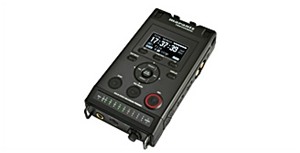
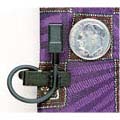
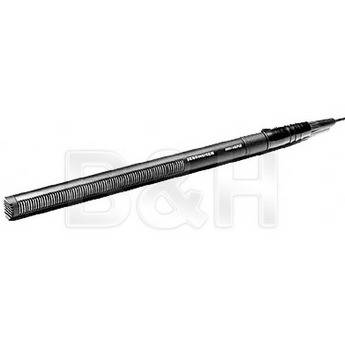
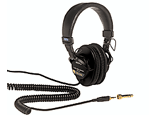
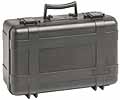
Cable: Get 10 to 15' of extra XLR cable. We use digiflex. Someday you'll thank me.
| Audio Recorder: Marantz PMD661. The Marantz PMD661 is a solid-state recorder. With no moving parts, this device is totally silent - what goes in comes from the environment, speaker and microphone only. The PMD661 is smaller than the Marantz PMD670, and unlike the PMD660, the phantom power actually works. If you have a dynamic microphone or a cheap condensor microphone, you need the 670. Both Marantz machines will record raw .wav files at 44,100 kHz so you do not have to worry about nasty compression. I have not yet tested the PMD671, but I suspect it is much better than the PMD661 or PMD670 as it is designed to record 24 bit and has better components. |

|

|
Lapel Microphone: countryman EMW P4F05B corded lapel microphone xlrcountryman EMW corded lapel microphone xlr. The countryman EMW lapel microphone doesn't go nuts when it rubs against clothing, so you can use it with consultants who like to dress up when being recorded. This microphone, when pinned close to the throat area on a shirt, will pick up and record even the quietest consultant tolerably well. If the person speaks up, the recording will be broadcase quality. Get the one with FLAT response- we're linguists and we don't like distortion. |
| Shotgun Microphone: The sennheiser MKH 416 condensor microphone is simply amazing. It has a built-in heat source so it can work outdppors, it attenuates sounds to the side very effectively, recording what is in front without distraction. And the sound quality is superb. |

|

|
Headphones: sony mdr 7506 foldable These headphones won't win audiophile awards (get a set of Beyerdynamic DP 931's or Sennheiser 650 HD's if your as picky as this web-site writer), but they have good sound, are small, comfortable, and the casing can double as a hammer for small nails. I really like them in the field. |
| Case: military uk 718 case. This case is big, bulky and heavy. So why would I recommend it when I just helped you build a nice, light kit? Because you can drop the case of a 3 story building, walk down to the ground, pick up the case, and pull out the contents for use without bothering to check if they are OK. And its waterproof. |

|
| Batteries: 4 * AA NIMH rechargeable batteries w/ battery pack. Nickel Methal Hydride batteries have a very sudden decay in energy. They work and work and work - and then they die. That's what you want in a good rechargeable battery because they won't reduce the quality of recordings in the field as your day wears on. |
Flash Memory: AT least 2GB of flash memory for 6 hours of mono or 3 hours of stereo recording. Don't skimp on the memory.
Cable: Get 10 to 15' of extra XLR cable. We use digiflex. Someday you'll thank me. |
|
Laptop Computer: 15" macbook pro or 15" MacBook Pro with retina display. Why a Mac? Simple: they're tiny, reasonably tough, and they have fast hard drives. Most importantly, they have the same warranty everywhere on earth, which matters when you travel. Whatever you buy, make sure you get the MOST memory and the BIGGEST hard drive. You'll thank me later. Make sure you install the latest copy of MS Office, PRAAT, AUDACITY, and the 3 year warranty called Applecare Protection Plan. But remember they only work with two USB Preamps I've tested - the rest are truly aweful: |
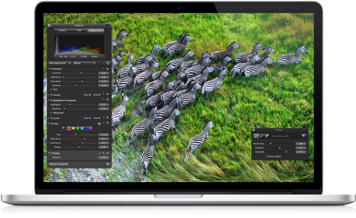
|
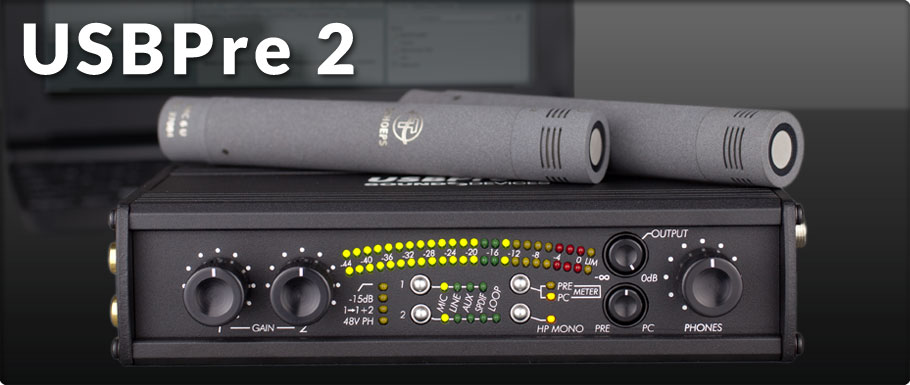
|
USB Premap: SoundDevices USBPre 2 is by far the best I've tested. Better than the USB Pre, and that's saying something. It can do 24 bit recording, has super-low noise on a PC (no suprise) and mac (a miracle!). It records extremely loudly (is very "hot") compared to most models. Also, it's records loudly (is very "hot") compared to other models I've tried. That means you can actually capture what quiet speakers say without deafening hiss in the background. It also means the waveform can be analyzed with (relative) ease. If you are short on money, the cheaper, 16 bit M-Audio USB MicroPre is good product. |
| Tripod Body: MANFROTTO 190CL Tripod. MANFROTTO makes nice tripods, this one is not the best on the market, but it's very good, easy to use, and super-flexible on bad ground. Also, it's not that expensive by A/V standards. |
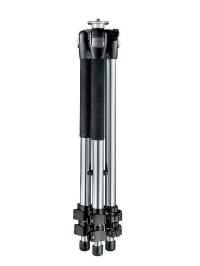
|
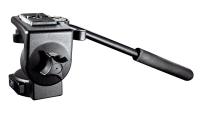
|
Tripod Head: MANFROTTO 128RC Head. The Manfrotto tripod head allows hot-swappable insertion and removal of the camera. This makes assembly easy, safe and fast. Also, because it's a micro-fluid head, you dont' have to worry about stripping threads or otherwise damaging the head when you turn it too fast or forget to losen the wing nuts - which you will. That's all I ask for out of a tripod head. |
| Tripod Bag: MANFROTTO MBAG80P Bag This bag was designed to hold the tripod and tripod head described above. 'nuff said. |
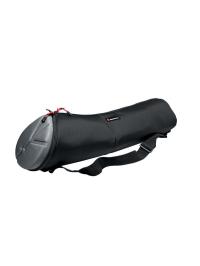
|

|
Microphones: Countryman EMW cordless lapel microphone. You need TWO of them, and you need to have the ends custom fitted for the wireless transmitter/receivers. There's no way around this, and you'll be very unhappy if you don't remember to get it done. Any professional A/V place can do the job for you. Don't tolerate bad work - make sure you test the equipment within 30 days. |
| Transmitters: Sennheiser EW112PG2 lapel wireless transmitter/receiver. These things are excellent, the 2 AA batteries each unit takes (for a total of 16 AA batteries in your camera kit - that's 2 batteries per part * 2 transmitter/receiver units * 2 for backup) last the whole day. Remember to read the instructions on these units and change the frequency for one of the transmitters. Otherwise you'll get audio crossover and you'll be recording a mess instead of crystal clear stereo. |
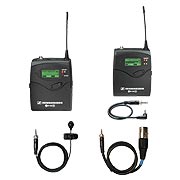
|
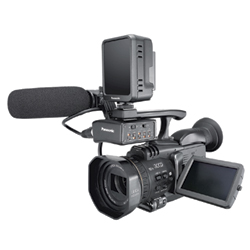
|
Camera: PANASONIC AGDVC30 3 CCD Mini DV Camera Pack w/ PANASONIC XLR adapter. This is an excellent mid-range 3CCD professional video camera. Mini DV records 1 hour per tape only, but you get good quality and most importantly NO SOUND COMPRESSION. You'll be happy when you want to do a A/V time sync that actually works. |
| Camera bag: LOWEPRO Nova 5 AW Softbag. This bag is exactly the right size for the camera, transmitter/receivers, batteries, and all your extra gear. It's snug if you want everything, but just big enough to be comfortable and easy to use. |
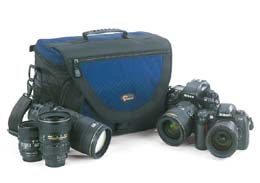
|
|
Camera Battery: 10 Hour Panasonic LION battery. Make sure you get the biggest, longest lasting super-battery for this camera. Life is much easier with extra battery power. You can use the POS battery that comes with the camera as emergency backup.
|
MINI DV tapes: PANASONIC Master Grade Tapes. Trust us, these tapes don't have grease embedded in the casette, so they won't slowly jam the works and ruin you multi-thousand dollar camera. Plus, if you get them at your professional store, you'll actually pay less than you would at Staples for an inferior product. |